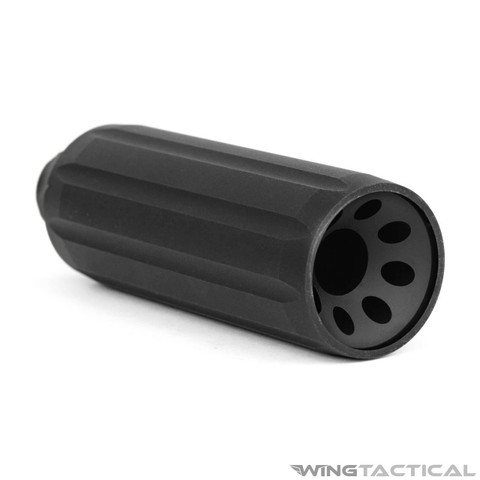People have been adding improved sights to rifles since at least the beginning of the last century. The first type of "red dot"-style rifle optics came with the invention of the "reflex" or "reflector" sight by Irish optical designer and telescope maker Sir Horace Grubb in 1900. Many other designs sprung up from Grubb's initial reflex sight design — some were lit by ambient light, some by batteries.
Wing Tactical is proud to offer the best in AR-15 sights and optics for today’s shooters and builders. Explore our collection and discover the best in modern optics.
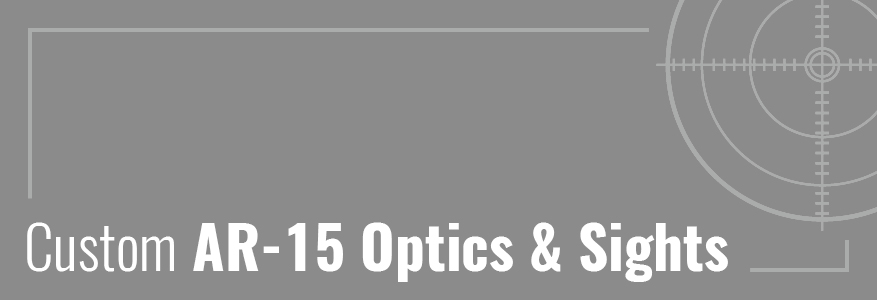
AR-15 Sights and Optics Buying Guide
The first type of sight to offer a true red dot for aiming was the Weaver Qwik Point in the late 60s and early 70s, which collected ambient light into a red plastic light pipe, hence the red dot effect. Following closely on Weaver's tail was Aimpoint AB, a Swedish optics company that introduced the first truly electronic red dot with their "Aimpoint Electronic" sight in 1975. The LEDs on the first Aimpoint red dot sights could run for anywhere from 1,500 to 3,000 hours, with Aimpoint recommending changing the batteries on the sight on a yearly basis.
A number of copies, imitators, and competitors soon followed the original Aimpoint red dot sight. The US military itself ended up using Aimpoint's CompM2 as their AR-15 red dot sight of choice from 2000 onward.
Today, many manufacturers have created their own AR-15 sights and you have plenty of options to choose from for your own build.
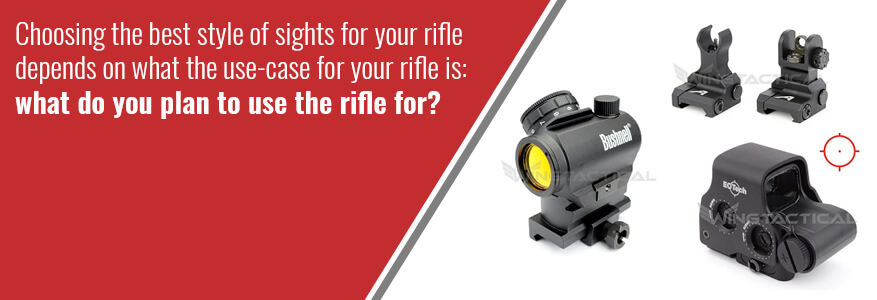
You have several different choices when it comes to custom AR optics, including holographic sights, red dot sights, reflex sights, and flip-up sight sets. Each style of sight has its advantages and disadvantages, and each has a different best-use case, whether that's range shooting, hunting, or home defense. Choosing the best style of AR-15 sights depends entirely on the use case of your rifle.
Since the use of optics has been steadily on the rise, many shooters tend to transition straight to using optics instead of going through their paces with the iron sights attached to their rifles. However, using iron sights can have its benefits, and is something that every shooter should learn how to do. After all, what if your optic fails?
Iron sights tend to be exceptionally precise, and you can make upgrades and adjustments to them to suit your preferences. It's entirely possible to engage a target 500 yards out with a good pair of iron sights, especially if those sights are augmented with a tritium front sight post, making shooting easier at long ranges in low-light environments.
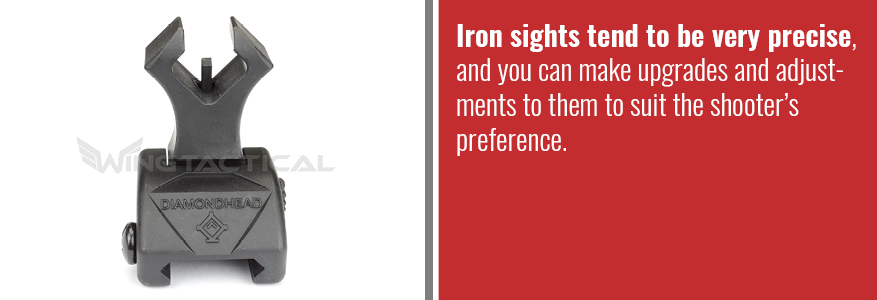
Additionally, many shooting competitions, such as the NRA high-power competition, require shooters to use iron sights only. So if you plan to do any competition shooting, iron sights are the way to go.
As compared to iron sights, optics get on target faster, and the variety of reticle choices available means that a shooter can choose the optic that is right for them. Additionally, red dot optics don't need any upgrades or adjustments for night shooting or low-light environments.
If you choose to make the transition from using just your iron sights to using an optic with your iron sights as your backup, remember to continue to train with your iron sights. You may be forced to go back to more primitive AR optics when your digital sights run out of batteries or are damaged.
Train to become as proficient as you can with the iron sights on your rifle, especially when you have downtime. This will allow you to switch between the two at will, meaning that you can save the iron sights for redundancy while still leaving a red dot or holographic sight as your primary AR-15 sight.

Spike Front Sights
Spike front sight posts, like those designed by Blitzkrieg Components, are manufactured with a luminescent stripe (usually orange, green, or white) for use in low-light environments. A light source, such as a flashlight, charges each spike-style front sight. Once charged, it will glow very brightly for around five minutes, then glow a little less brightly over the next 20-30 minutes before finally dimming down to a lower-level dim glow, where it will remain for several hours.
While spike-style front sight posts for the AR-15 typically function as a simpler custom red dot sight, they can also be used as the front component in a pair of custom flip-up sights for your AR-15.
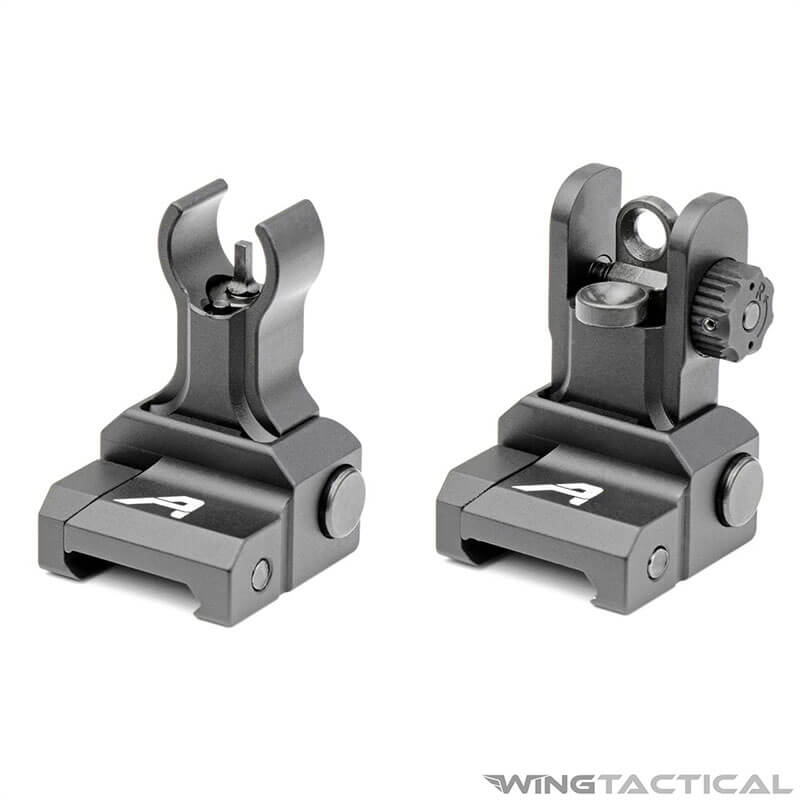
Flip-Up Iron Sights
A pair of custom flip-up sights are an excellent choice for when you need to engage targets at longer ranges but still want to be able to use your rifle's iron sights for closer targets. There are two kinds of flip-up sight sets that you can buy for the AR-15: upright flip-up sights and offset flip-up sights, each with its advantages and disadvantages.

Upright Flip-Up Sights
Upright flip-up iron sights are a style of flip-up sight that you usually mount behind the shooter's primary optic, such as a scope, red-dot, or holographic sight. You can then use them to engage targets that are too close for normal optics (in the case of a scope) or if you don't have the time to engage with their regular optic (as may be the case with red dot or holographic sights).
However, conventional flip-up front and rear sights for the AR-15 do have their drawbacks. The optics themselves can end up getting packed with dirt, mud, or grime, making them utterly useless and forcing you to rely on your primary optic. Similarly, since the front and rear flip-up sights have to sight through the primary optic to establish a sight picture, having a broken primary optic can render the conventional flip-up sights useless.

Offset Flip-Up Sights
Offset flip-up sights are, as their name implies, a pair of flip-up sights that are offset from the shooter's primary optic, usually at a 45-degree angle. This allows a shooter to mount a longer-range optic as their primary optic (such as a scope, red-dot, or holographic sight) and leave the flip-up sights offset so that they can engage targets without having to fiddle with the primary optic.
Still, offset flip-up sights do have drawbacks. They present a heightened possibility of getting in the way and can make it harder to use the rifle period. Using a pair of offset sights also means that the shooter has a higher chance of banging the sights against something, getting them caught on something, or even just bending or otherwise damaging them as compared to conventional sights.
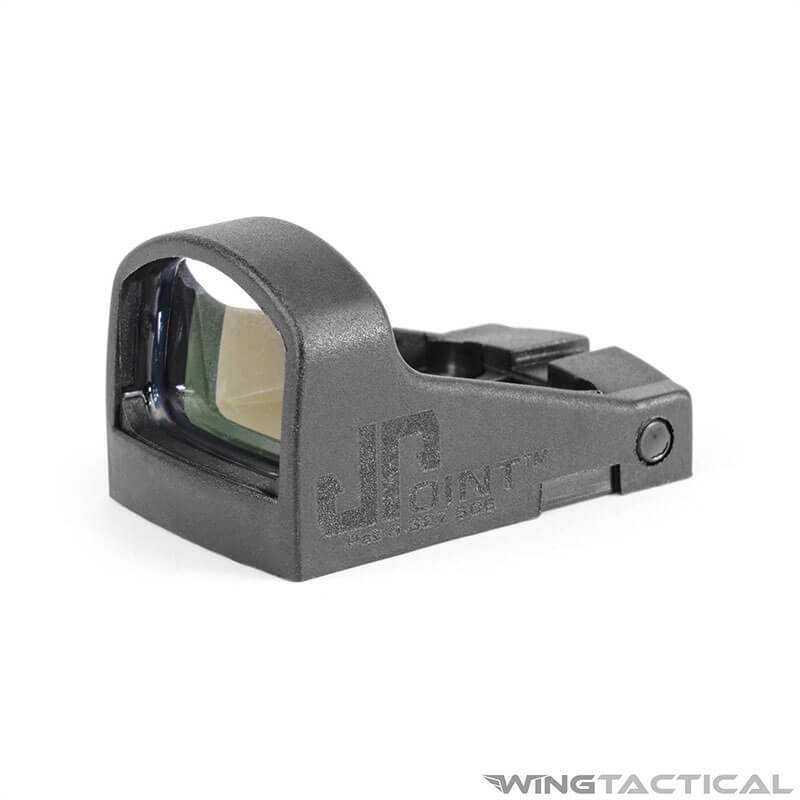
Holographic and Red Dot Sights
Only one company, Electric-Optic Technologies, currently manufactures holographic sights. Electric-Optic Technologies offers its holographic sights under two brand names: Bushnell and the more well-known EOTech. Holographic sights differ from red-dot/reflex sights in that they superimpose a reticle onto your target picture via a laser, which illuminates a hologram contained within the objective lens (as opposed to being projected onto it, which is the case with red dot and reflex sights).
Because of the structure of holographic sights, they fall into the category of smaller, lighter "heads-up" style sights rather than the tube-bodied scope-style sights, as is common with some kinds of red dot sights.
Trust Wing Tactical for All Your Optics Needs
Whether you need a simple pair of flip-up iron sights, a new front sight post, or the newest EOTech optic, trust Wing Tactical for all of your optics needs. Since 2013, Wing Tactical has striven to provide its customers with the best accessories at the lowest prices possible, all through one convenient website. If you want a new optic for your favorite rifle, browse our inventory to find the option that's right for you.
If you’re not sure where to start with AR optics, our customer service team is happy to point you in the right direction.
Frequently Asked Questions
Which sight is right for your rifle?
When it comes to choosing the sight that's right for your rifle, you have to ask yourself one main question: what am I going to be using it for? The type of activity you use your rifle for most will predicate what kind of sight you purchase. For example, sights for home defense will vastly differ from those you'd buy to go range shooting or hunting.
When choosing an optic, there are three primary considerations you need to consider:
- Durability – You need to know an optic is durable before you can trust it in any potentially dangerous situations such as home defense, hunting, or military use. Can you train hard with this optic and still be able to depend on it in a non-training situation?
- Precision – Is the optic accurate? You rely on an optic to help you when you need to put rounds on target. If you're doing your part, the optic should be able to pull its own weight — no one wants to be second-guessing their choice of optic in the middle of a life-threatening situation.
- Ease of use – How easy is this optic to use, clean, repair, or replace? Optics need to remain uncomplicated and easy to use.
Which sights are best for home defense?
When choosing sights for home defense, you need to look for these crucial features:
- Quick target acquisition – Many sights come with different front post sizes and reticle sizes. You need something that will enable you to find your targets quickly and keep the reticle on that target, so you know exactly where you're putting your fire.
- Night usage – Consider how brightly the light of your optic shines, or if it even has one at all. Putting a brightly lit dot on target, especially in low-light conditions, will make nighttime usage much easier.
- Ease of use – The third and most vital consideration is the ease of use. How easy is it to sight targets with this optic, especially if they’re up close? Can you use it accurately when you practice at the range? Does it need a lot of cleaning or frequent battery replacement? All of these are important considerations when it comes to ease of use.
A red-dot or holographic sight (such as an Aimpoint or EOTech) offers all of these, especially if you purchase one in the more standard heads-up configuration rather than a tube-style optic. They're perfect for close or medium range shooting, which commonly occurs during home defense situations. Most also either come stock with red optics (ideal for night shooting) or come with the option to add a tritium optic, which is perfect for low-light conditions.
Which sights are best for range and recreational shooting?
When it comes to range shooting, choose the sight with which you're most comfortable. Range shooting often acts as practice, so you must find the sight you want to use and practice with. That being said, most range-shooting competitions favor using iron sights instead of holographic or red dot optics.
If you want to get involved in range shooting competitions, consider using a pair of custom flip-up front and rear sights for your AR-15. If you're just looking to spice up your iron sights, another option would be to use a spike-style front sight post as a quasi-red dot while still enabling you to use the regular iron sights that came with your rifle.
Ultimately, though, the type of sight you use for range shooting depends on what kind of range shooting you're doing. If you're just going for practice, go either with your standard-use sights or a red-dot/holographic sight for easier target acquisition. If you're going for competition, stick to iron sights. These sights allow for quick target acquisition while providing shooters clear views of the game to execute a clean and quick shot.
Which sights are best for hunting?
AR-15 rifles are often used when hunting feral pigs, boars, coyotes, groundhogs, foxes, prairie dogs, raccoons, and bobcats. The .223 round is ideally designed for taking these quick moving small to medium sized game. With the style this game is hunted and the short to medium range you will be shooting, a red dot or holographic sight for your AR-15 is ideal. A red dot or holographic weapon sights system allows a hunter to get a clear and quick acquisition of their target, leading to better shots and cleaner kills.
When it comes to red dot or holographic optics, the three best-known optics companies are Aimpoint, Trijicon, and EOTech. While Aimpoint has been in the business the longest, EOTech makes some of the better hunting optics, including one that offers 3X magnification for taking long-distance shots.
Which sights are best for military use?
For military use, red dot sights tend to be the order of the day. The US Army has introduced an Aimpoint optic, the CompM2, as one of its standard optics. The CompM2, the M68 Close Combat Optic, has been in military service since 2000. So, if you want a military-style optic, consider getting a red dot sight.






